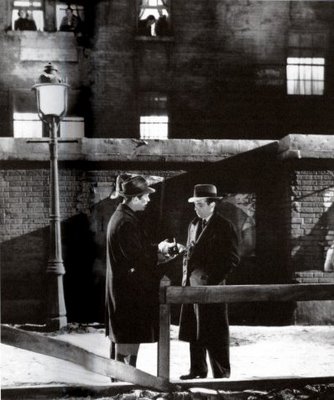
Despite my Free Lifetime (of my daughter's job as an usher) Movie Pass, I still watch most of my movies at home. And even with the modest glories of my 36" TV and sound-system-in-a-box, I am always aware that viewing at home is the original humbling experience--particularly for the movie. I'm not saying anything new here about the losses incurred when one watches a movie on TV; it's just that yesterday I caught The Maltese Falcon on Turner Classic Movies: It was the first movie I grew up watching on TV that I saw in a real movie theater--in Philadelphia, I think. I'm not sure when; probably in the wake of the '40s nostalgia boomlet encouraged by Play It Again, Sam (1972), in which Woody Allen gets dating tips from Bogart. That seems right: somewhere in the middle of that decade, just when I was finishing high school and finding no other place to lose it than at the movies. (Apologies to Pauline Kael.)
I can still distinctly remember the lather I'd worked myself into, floored by the booming Warner Bros. intro., the sheer size of the faces--having always been so small and manageable on TV--and the sudden unfolding of the movie, so that I began to realize what really happens when you can see the ceilings of a room, and why a low-angle shot makes the viewer uneasy and the screen figures foolish in their grotesque assertions of self. And more than that: I realized there are no "oldies but goodies." John Huston's directorial debut seemed almost as fresh and compelling as anything I could see down there in the dark of the mid-'70s. I clutched at the movie like a greedy--no, a starving man--or one who until that moment had thought he had eaten, and slowly realized that all along he had only been dreaming of a feast. And every course, every morsel, was exactly what I craved--but was also a surprise. I noticed Huston's use of mirrors and shadows, and the arrangement of the characters in the frame. I puzzled over the small details of match-stands, the contents of Joel Cairo's pockets, the look of the glassware and guns. I was no longer primarily hearing the movie, but seeing it.
 This was important to me because, as it is for everyone who loves it, The Maltese Falcon can primarily be a verbal experience. The script and performances are irresistible. It is eminently quotable, from Spade's toast--"Success to crime"--to his dismissal of Wilmer's "Keep on riding me and they're gonna be picking iron out of your liver": "The cheaper the crook, the gaudier the patter"; and the speeches, from Joel's reasonable explanations to Brigid's lies, and on to Spade's famous explanation of why he's going to send her over--and at the center of all this talk, of course, is Gutman's meta-speech about talking:
This was important to me because, as it is for everyone who loves it, The Maltese Falcon can primarily be a verbal experience. The script and performances are irresistible. It is eminently quotable, from Spade's toast--"Success to crime"--to his dismissal of Wilmer's "Keep on riding me and they're gonna be picking iron out of your liver": "The cheaper the crook, the gaudier the patter"; and the speeches, from Joel's reasonable explanations to Brigid's lies, and on to Spade's famous explanation of why he's going to send her over--and at the center of all this talk, of course, is Gutman's meta-speech about talking: "I distrust a close-mouthed man. He generally picks the wrong time to talk and says the wrong things. Talking's something you can't do judiciously, unless you keep in practice. Now, sir, we'll talk if you like. I'll tell you right out, I'm a man who likes talking to a man who likes to talk."
I cannot underestimate the power of this revelation, that The Maltese Falcon was as much a visual as a "dramatic" experience. There it was, this riveting, talking picture, suddenly a picture before it could talk, a squared-off-yet-tilting space, growing smaller and smaller, until the bar-shadowed elevator takes Brigid down down down. The stuff that dreams are made of, and how: After The Maltese Falcon on the big screen, looming up there, wide open and heavy with its own gravity, I could never fully separate a movie's story from its images, its manipulation of space and sequence. For better or worse, for me every good movie--and some of the almost-indifferent ones--shares in the solidity of 2001's monolith, a flat surface that you gaze at, and that gazes back at you. And this time no apologies, least of all to Nietzsche.

No comments:
Post a Comment